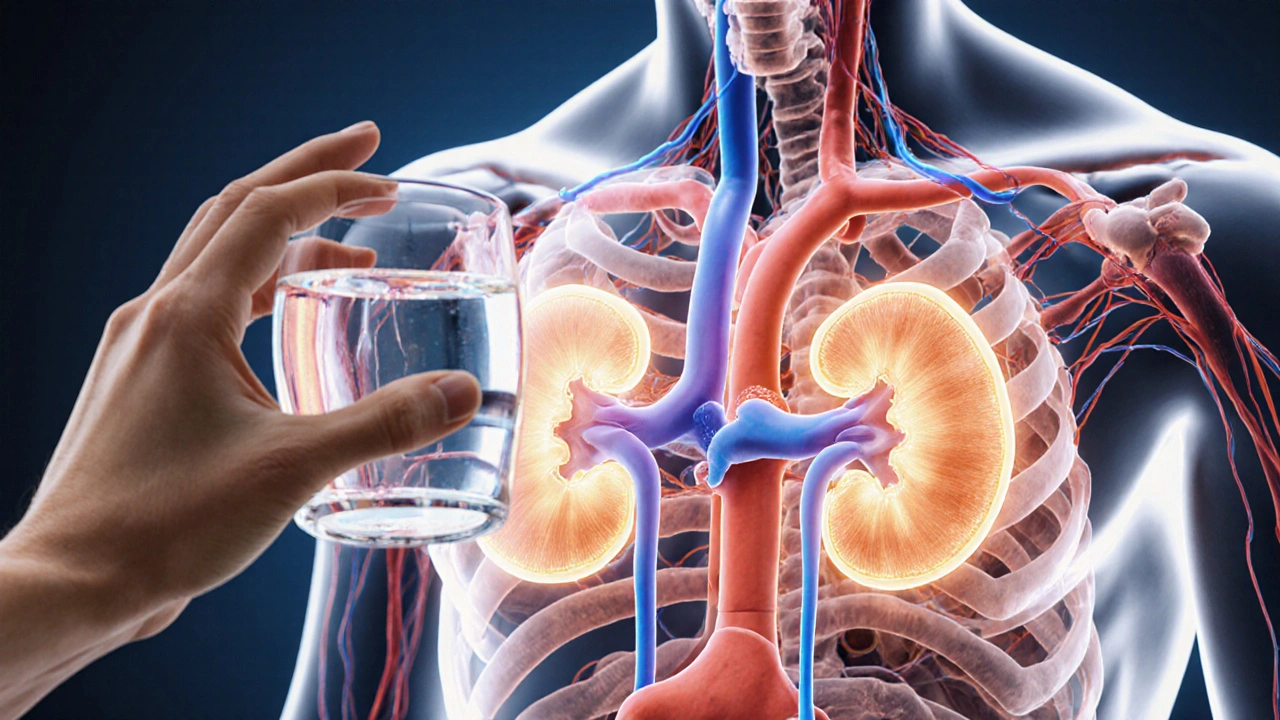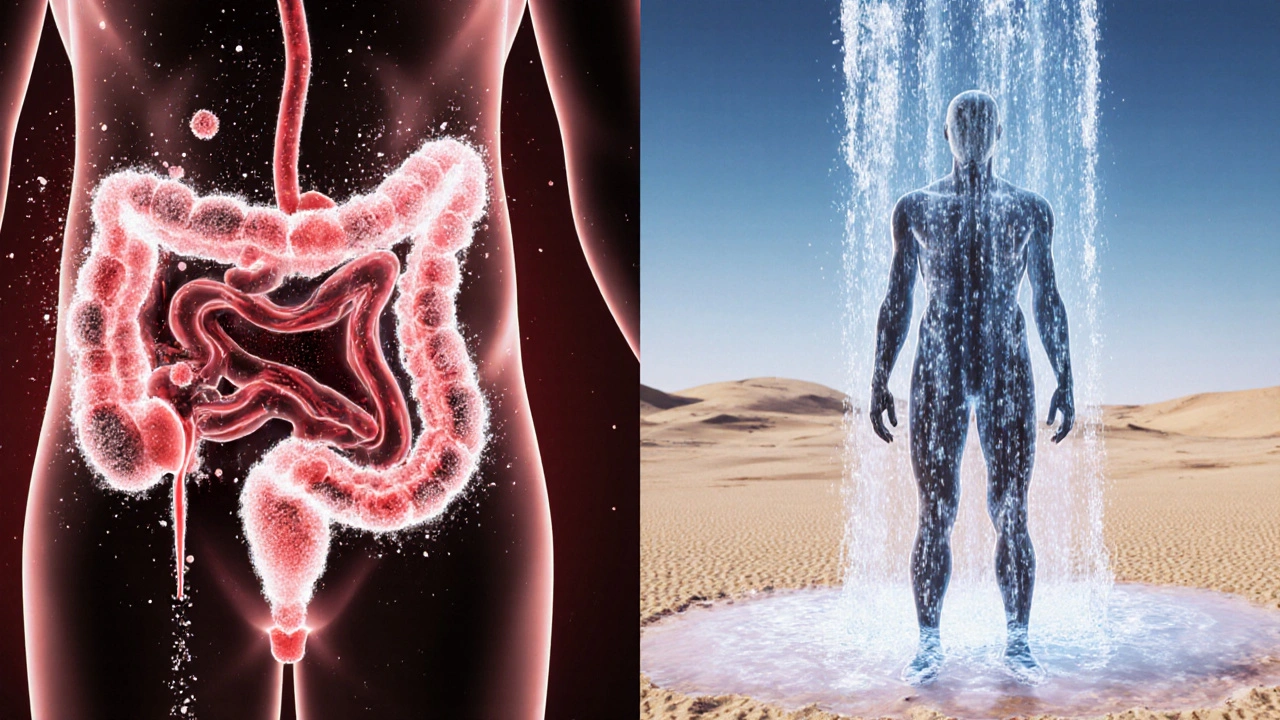Why Increased Thirst Leads to Frequent Urination - Causes & When to Seek Help

Thirst & Urination Symptom Checker
This tool helps you assess your symptoms of excessive thirst and frequent urination. Answer the questions below to get personalized guidance on whether you should see a doctor.
Result will appear here
Your assessment will be shown here
Ever notice that when you feel super thirsty, you also end up running to the bathroom a lot? That isn’t just a coincidence - it’s how your body tries to keep its water balance in check. Understanding why frequent urination shows up alongside an unquenchable thirst can help you spot a harmless hiccup or a signal that something more serious is happening.
Key Takeaways
- Polydipsia (excessive thirst) and polyuria (excessive urination) often appear together because the kidneys and hormones work to regulate fluid levels.
- Common culprits include diabetes mellitus, diabetes insipidus, high calcium levels, certain medications, and kidney problems.
- Red‑flag symptoms - like sudden weight loss, vision changes, or severe dehydration - merit a medical check‑up.
- Simple lifestyle tweaks (monitoring fluid intake, checking blood sugar, avoiding excessive caffeine) can ease mild cases.
- When in doubt, a doctor can run basic labs - blood glucose, electrolytes, and urine tests - to pinpoint the cause.
How Your Body Controls Water Balance
Two main systems keep the amount of water in your body steady: the kidneys and the antidiuretic hormone (ADH). When you drink, blood osmolarity (the concentration of solutes) drops. The brain’s Antidiuretic hormone is a hormone released from the pituitary that tells the kidneys to re‑absorb water, making urine more concentrated. If you’re dehydrated, ADH levels rise, and you produce less urine. When you’re over‑hydrated, ADH falls, and the kidneys dump the excess as dilute urine.
Because ADH works behind the scenes, any trouble with its production, release, or kidney response can cause the classic duo of thirst and peeing a lot.

Common Medical Reasons for Both Symptoms
Below are the most frequent conditions that trigger both polydipsia and polyuria. Each one disrupts the normal osmoregulation loop in a different way.
Diabetes mellitus is a chronic condition where blood glucose levels stay high, prompting the kidneys to excrete extra sugar in the urine
Glucose pulls water into the urine via osmosis, leading to larger volumes of dilute urine. As you lose water, the brain signals thirst. Classic signs include sweet‑tasting urine, blurry vision, and slow‑healing cuts.
Diabetes insipidus is a rare disorder where either ADH isn’t produced enough (central) or the kidneys ignore ADH (nephrogenic)
Without ADH’s water‑saving effect, the kidneys release massive amounts of very dilute urine. The body compensates with intense thirst. Unlike diabetes mellitus, blood sugar stays normal.
Hypercalcemia is elevated calcium levels in the blood, often from overactive parathyroid glands or certain cancers
High calcium interferes with the kidneys’ ability to concentrate urine and can blunt ADH response, so you urinate more and feel thirsty.
Kidney disease is any condition that impairs the kidneys’ filtering capacity, such as chronic kidney disease or acute tubular injury
When nephrons lose function, they can’t re‑absorb water efficiently, leading to increased urine output. The body’s natural reaction is to signal thirst.
Medications - especially diuretics
Drugs like furosemide, hydrochlorothiazide, and even caffeine boost urine production. They’re intentional “water‑pushing” agents, so you’ll naturally feel thirsty after a dose.
Pregnancy
Hormonal changes increase blood volume, and the growing uterus puts pressure on the bladder. Both factors cause you to drink more and pee more often.
Quick Comparison of Top Causes
| Condition | Typical Thirst | Typical Urination | Key Lab Clue | Primary Treatment Focus |
|---|---|---|---|---|
| Diabetes mellitus | Very high, often nocturnal | Large volumes, sugary | Fasting glucose >126mg/dL | Glycemic control (insulin, oral meds) |
| Diabetes insipidus | Extreme, constant | Up to 20L/day, very dilute | Low urine osmolality, normal glucose | Desmopressin (central) or thiazides (nephrogenic) |
| Hypercalcemia | Moderate‑high | Increased, may be concentrated | Serum calcium >10.5mg/dL | Hydration, bisphosphonates, treat underlying cause |
| Kidney disease | Variable, often dry mouth | Polyuria early, oliguria later | Elevated creatinine, reduced eGFR | Nephrology management, dialysis if advanced |
| Diuretic use | Temporary rise | Predictable increase after dose | Medication list, electrolyte shifts | Adjust dose or timing, replace electrolytes |
Red‑Flag Signs - When to Call a Doctor
If you notice any of these alongside thirst and peeing more often, seek medical attention promptly:
- Sudden, unexplained weight loss (more than 5% in a month)
- Blurred vision or frequent infections
- Fever, nausea, or vomiting
- Severe dizziness or fainting spells
- Blood in urine or persistent pain during urination
These symptoms suggest a metabolic disturbance or infection that needs testing.
Practical Ways to Manage Mild Cases
For many people, the duo of thirst and extra bathroom trips is benign and can be tamed with a few habits:
- Track fluid intake - aim for 2‑3L per day unless a doctor tells you otherwise.
- Prefer water over sugary drinks; caffeine can act as a mild diuretic.
- If you have diabetes, check blood glucose before meals and keep a log.
- Watch electrolytes - a salty snack can help when you’re on a loop diuretic.
- Schedule bathroom breaks - training your bladder can reduce nighttime trips.
When lifestyle tweaks aren’t enough, a simple blood panel (glucose, calcium, creatinine) and a urinalysis often reveal the underlying cause.
Frequently Asked Questions
Why does my body make me thirsty after drinking a lot of coffee?
Caffeine blocks the re‑absorption of sodium and water in the kidneys, so you lose more fluid in urine. The net loss triggers the brain’s thirst center, making you want to drink again.
Can a high‑protein diet cause more urination?
Yes. Metabolizing protein produces urea, which the kidneys excrete with water. A surge in protein intake can slightly increase urine volume and make you feel thirstier.
Is nighttime urination (nocturia) always a sign of disease?
Not always. Aging, excess evening fluids, or a full bladder after dinner can cause nocturia. However, if it’s paired with high blood sugar or a new medication, it’s worth checking with a clinician.
How does pregnancy affect thirst and urination?
Hormones increase blood volume, and the growing uterus presses on the bladder. Both lead to more frequent urination, and the body compensates by boosting thirst.
What simple test can rule out diabetes mellitus?
A fasting blood glucose measurement. Values below 100mg/dL are normal; 100‑125mg/dL suggests pre‑diabetes, and 126mg/dL or higher on two separate days confirms diabetes.
Darius Reed
October 15, 2025 AT 06:46Yo, i liket the breakdown but i think the post could use a bit more on why caffeine makes u thirsty.
Karen Richardson
October 26, 2025 AT 20:33The article correctly distinguishes between diabetes mellitus and diabetes insipidus, which many lay readers often conflate. However, it would benefit from citing specific reference ranges for serum calcium when discussing hypercalcemia. Additionally, including a brief note on how certain antipsychotics can induce SIADH would enhance completeness. Overall, the content is accurate but could be bolstered with these minor clarifications.
Cynthia Petersen
November 7, 2025 AT 10:20Oh great, another reminder that my coffee habit is basically a built‑in diuretic. Guess I’ll keep my water bottle handy next time I sip that “miracle‑worker” brew.
Marcia Hayes
November 19, 2025 AT 00:06I appreciate how the piece breaks down the mechanisms without drowning us in jargon. It’s helpful for anyone who’s just noticing they’re up at 3 a.m. to pee.
Danielle de Oliveira Rosa
November 30, 2025 AT 13:53When you consider the body as a finely tuned orchestra, thirst and urination are simply two instruments reacting to the same conductor – homeostasis. If one section falters, the others compensate, creating the symptoms we observe. This perspective reminds us that the experience is not merely a nuisance but a signal of deeper balance.
Tarun Rajput
December 12, 2025 AT 03:40Allow me to expound at length on the intricate physiologic cascade that underlies the seemingly mundane phenomenon of concomitant polydipsia and polyuria. When plasma osmolality declines after oral fluid ingestion, osmoreceptors located in the hypothalamic supraoptic nuclei diminish their secretion of antidiuretic hormone (ADH), thereby attenuating the renal collecting ducts' permeability to water. Consequently, the kidneys excrete a larger volume of hypotonic urine, a process that, while efficient, precipitates a net loss of free water that the brain promptly registers as thirst. In parallel, the renin–angiotensin–aldosterone system may become modestly activated to conserve sodium, an effect that indirectly modulates water reabsorption. Moreover, in pathological states such as central diabetes insipidus, the very synthesis of ADH is compromised, leading to an unabated diuresis that can exceed twenty liters per day, a volume that no reasonable intake can match without precipitating severe hypernatremia. Nephrogenic diabetes insipidus, by contrast, reflects a renal insensitivity to ADH, often due to mutations in the V2 receptor or aquaporin‑2 channels, thereby mimicking the central form’s clinical picture despite intact hypothalamic function. Hypercalcemia introduces yet another layer of complexity, as elevated calcium concentrations can antagonize ADH action at the tubular level, reducing water reabsorption and stimulating thirst through direct effects on the thirst center. Chronic kidney disease illustrates a progressive decline in nephrons, diminishing glomerular filtration rate and impairing tubular concentration ability, which culminates in polyuria that may evolve into oliguria as the disease advances. Pharmacologic agents, notably loop diuretics such as furosemide, act on the Na‑K‑2Cl symporter in the thick ascending limb, forcibly delivering sodium and water to the distal nephron, thereby amplifying urinary output and provoking compensatory polydipsia. Even seemingly innocuous substances like caffeine inhibit phosphodiesterase, leading to modest natriuretic and diuretic effects that can become clinically relevant in susceptible individuals. Pregnancy, a state of expanded plasma volume and increased glomerular filtration, exerts mechanical pressure on the bladder and hormonal influences that further stimulate thirst and urination. Finally, the interplay of these mechanisms underscores the importance of a methodical clinical assessment: measurement of serum glucose, osmolality, calcium, and creatinine, coupled with urine specific gravity, can delineate the precise etiology and guide targeted therapy, whether it be insulin administration, desmopressin replacement, calcium‑lowering interventions, or adjustment of diuretic regimens.